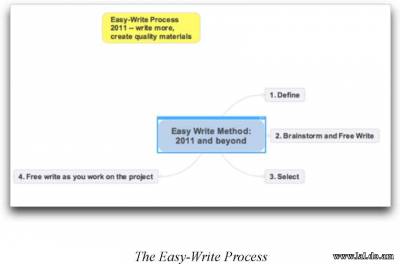You can use the Easy-Write Process for large projects and for small. Use it for everything. :-)
Now let's go through the process step by step.
-
Define the project, and sell more
When you define a project, ask yourself: Who, What, How, When, Where and Why. These questions are often known as the ”5Ws and an H”.
Let's say you're writing an article for a magazine. When you write for a
publication, you write a PITCH first. All this means is that before you write the article, you write the editor a letter asking whether she's interested in the article for her publication.
You use the Easy-Write Process to craft the pitch. The benefit of using Easy Write, is that you're more likely to sell the article, because the pitch will be crafted well. And if, as often happens, the editor calls you to discuss the article, you'll have the material you create with the Easy-Write Process in front of you - and you can come up with answers to any questions she has quickly and easily.
Don't spend a lot of time on your Definition. Just write one, two or three sentences: ”This is a how-to article for MacAddict magazine, describing how to use iWeb to create a Web site in less than an hour, and get it online.”
-
Brainstorm and free write to get lots of ideas -make your writing more powerful and more original
In our magazine article pitch above, if you didn't know about the Easy Write Process, you might be content to send the pitch off as-is. Yes, you'd add another hundred words to it, but the thrust of the pitch would be - teach readers how to get a small Web site online.
Not bad. However, how much would you like to bet that 200 other writers also got the same idea and sent it to the editor? In a situation like that, the person whose email message gets to the editor first, wins.
You'll increase your chances of selling YOUR article, when you BRAINSTORM. Then, no matter how many writers got there before you, your article wins, because it's not the same as everyone else's. Yours has more originality because you brainstormed, and your pitch is more powerful.
So, BRAINSTORM.
Give yourself ten minutes (use a timer) and just write down every idea you can think of, the crazier the better. Write down everything - don't censor yourself, and don't think "this is crazy." You want way out, crazy ideas, you want dull ideas, you want mad ideas. Keep writing for ten minutes.
Free writing: your key to genius
Next, choose one idea, and free write on it.
Get a timer, set it for 10 minutes, and just write.
Write down everything which comes to you. During the 10 minutes, don't lift your fingers from the keyboard - or your pen from the paper if you're writing by hand.
I often do my free writes by hand. I have a LiveScribe Echo pen, which I got specifically for free writing. I like to keep my free writes. I can easily create PDFs from my free writing sessions, and drag them into Evernote. Once they're in Evernote, I can access them years from now, wherever I happen to be.
That said, most of my free writes are just junk - they're brain dumps. I do many free writes each day however, and some I keep. They may be useful insights, ideas I want to work on further, or material I haven't got around to using in a project yet.
How you do your free writing is up to you - computer, paper - use whatever you feel comfortable using.
The only rules for free writing are:
• Time your sessions
• Keep writing, don't stop to correct spelling or grammar
If you find free writing useful it's worth reading Mark Levy's book, Accidental Genius.
-
SELECT the ideas that work - you’ll be amazed at the variety of choice you have
Once your brainstorming and free writing is complete - I usually spend half an hour or so on the process - it's time to SELECT the best ideas from your brainstorming/ free writing sessions.
You can use brainstorming/ select at the start of a project, and right through a project.
If you're writing a novel, you might brainstorm/ free write to create characters and create settings.
For example, let's say you're writing a novel and the novel won't come to life. If you're a novelist, you know how this feels. The story is mechanical. The characters are puppets - they don't act like real people, and you don't feel that you know them.
So you BRAINSTORM and free write.
Your definition might be: "Susan is a young mother, who's back at work after giving birth to her son, James. Her husband travels a lot in his business, and she feels that they are growing apart."
Your brainstorming session turns up several secrets that Susan is keeping from her husband: she had an affair in the first year of their marriage, she is not sure that James is her husband's son - he may be the son of a man she had the affair with. Plus, she feels that she may be in love with this other man. Plus, she has a compulsion to contact the other man. Then she meets the other man.
Can you see that this process makes your book much easier to write?
If you're a copywriter, and you're writing a sales letter, you might brainstorm the benefits that the product gives the purchaser. If you're writing an article, you may brainstorm to select the best title, or the best close for the article.
You'll find that brainstorming and free writing is a lot of fun, and because it gives you so much material to work with, you'll never be stuck, and you certainly won't procrastinate.
